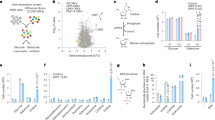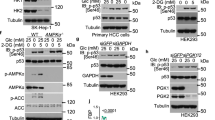Abstract
Reports from several laboratories have suggested that increased rates of glycolysis play an essential part in the initiation of DNA synthesis. This is based on observations that aerobic glycolysis: (1) occurs at low rate in resting mammalian cells and at very high rate in tumour cells1–3; (2) increases rapidly after DNA synthesis is initiated by addition of serum or purified growth factors4,5, and (3) correlates with the expression of the transformed phenotype6. Also, specific inhibitors of aerobic glycolysis prevent the initiation of DNA synthesis4. To determine whether the rapid activation of phosphofructokinase—and therefore glycolysis—by purified growth factors7 is necessary for the initiation of cell proliferation, we have isolated and studied two classes of glycolytic mutants. The first, isolated from Chinese hamster fibroblasts, has a total block in the glycolytic pathway8. The second, from hamster and Fisher rat fibroblasts maintains a permanent high rate of glycolysis. We have found that both classes of mutants retain normal control of DNA synthesis in response to serum. This dissociation indicates that growth-factor-stimulated glycolysis is not involved in the control of initiation of DNA synthesis and cell proliferation.
This is a preview of subscription content, access via your institution
Access options
Subscribe to this journal
Receive 51 print issues and online access
$199.00 per year
only $3.90 per issue
Buy this article
- Purchase on Springer Link
- Instant access to full article PDF
Prices may be subject to local taxes which are calculated during checkout
Similar content being viewed by others
References
Warburg, O. Science, 123, 309–314 (1956).
Ramaiah, A. Curr. Top. Cell Regul. 8, 297–345 (1974).
Suolinna, E. M., Lang, D. R. & Racker, E. J. natn. Cancer Inst. 53, 1515–1519 (1974).
Rubin, H. & Fodge, D. in Control of Proliferation in Animal Cells (eds Clarkson, B. & Baserga, R.) 1, 801–816 (Cold Spring Harbor Laboratory, 1974).
Diamond, I., Legg, A., Schneider, J. & Rozengurt, E. J. biol. Chem. 253, 866–871 (1978).
Carroll, R., Ash, J., Vogt, P. & Singer, J. Proc. natn. Acad. Sci. U.S.A. 75, 5015–5019 (1978).
Schneider, J., Diamond, I. & Rozengurt, E. J. biol. Chem. 253, 872–877 (1978).
Pouysségur, J., Franchi, A., Salomon, J. C. & Silvestre, P. Proc. natn. Acad. Sci. U.S.A. 77, 2698–2701 (1980).
Pérez, R., Franchi, A. & Pouysségur, J. Eur. J. Cell Biol. 22, 541 (1980).
Seif, R. & Cuzin, F. J. Virol. 24, 721–728 (1977).
Franchi, A., Silvestre, P., Pérez, R. & Pouysségur, J. (in preparation).
Thrash, C. & Cunningham, D. Nature 252, 45–47 (1974).
Silvestre, P. thesis, Univ. Nice (1980).
Zielke, R., Ozand, P., Tildon, T., Sevdalian, D. & Cornblath, M. Proc. natn. Acad. Sci. U.S.A. 73, 4110–4114 (1976).
Author information
Authors and Affiliations
Rights and permissions
About this article
Cite this article
Pouysségur, J., Franchi, A. & Silvestre, P. Relationship between increased aerobic glycolysis and DNA synthesis initiation studied using glycolytic mutant fibroblasts. Nature 287, 445–447 (1980). https://doi.org/10.1038/287445a0
Received:
Accepted:
Issue Date:
DOI: https://doi.org/10.1038/287445a0
This article is cited by
-
The ERK and JNK pathways in the regulation of metabolic reprogramming
Oncogene (2019)
-
Targeting prostate cancer cell metabolism: impact of hexokinase and CPT-1 enzymes
Tumor Biology (2015)
-
Two growth factor signalling pathways in fibroblasts distinguished by pertussis toxin
Nature (1987)
-
c-myc gene is transcribed at high rate in G0-arrested fibroblasts and is post-transcriptionally regulated in response to growth factors
Nature (1985)
Comments
By submitting a comment you agree to abide by our Terms and Community Guidelines. If you find something abusive or that does not comply with our terms or guidelines please flag it as inappropriate.



